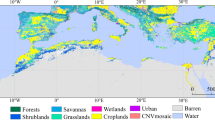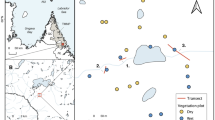Abstract
The Ordos plateau is a unique ecotone and is a focal region for the campaign to reduce or reverse desertification in China. This paper explores the relationship between vegetation and environmental gradients on the Ordos plateau based on a field survey of species distribution, vegetation distribution patterns, plant community structure, ecophysiological properties, and soil water content along an environmental gradient. The vegetation on the Ordos plateau may be divided into three types from east to west: steppe (eastern part), desert steppe (middle part) and steppe desert (western part). From east to west, precipitation declines significantly (from 400 mm to 150 mm). The spatial distribution pattern of vegetation at different sites was random. The density of shrub islands decreased from east to west, and their height and diameter were negatively correlated with precipitation. From east to west, the transpiration rate increased as temperature increased. Stomatal conductance was positively correlated with percentage of sunshine hours and negatively correlated with temperature. Water-use efficiency was positively correlated with average annual precipitation but negatively correlated with increasing percentage of sunshine hours. The results suggest that for effective revegetation, highly drought-tolerant species, such as Caragana tibetica and C. stenophylla, should be used and a lower percentage of vegetation cover expected (30–40%) in the western half of the Ordos plateau. In the eastern half, moderately drought-tolerant species, such as Artemisia ordosica and C. korshinskii, could be used and a higher percentage vegetation cover expected (40–50%).




Similar content being viewed by others
References
Archer S, Schimel DS, Holland EA (1995) Mechanisms of shrubland expansion: land use, climate, or CO2? Clim Change 29:91–99
Austin MP, Smith TM (1989) A new model for the continuum concept. Vegetatio 83:35–47
Austin MP, Nicholls AO, Margules CR (1990) Measurement of the realized quantitative niche: environmental niches of five Eucalyptus Species. Ecol Monogr 60:161–177
Brown AL (1950) Shrub invasions of southern Arizona desert grasslands. J Rangeland Manage 3:172–177
Brown JR, Archer S (1999) Shrub invasion of grassland: recruitment is continuous and not regulated by herbaceous biomass or density. Ecology 80:2385–2396
Chen CD (1964) Where is the boundary in middle part of typical steppe sub zone and desert steppe sub zone (Ordos plateau) in China? (In Chinese with English abstract). Acta Phytoecol Sin 2(1):143–150
Chen XD, Chen ZX, Zhao YX (1998) The determination of ecotone and the characteristics of biome on Ordos plateau (In Chinese with English abstract). Acta Phytoecol Sin 22:312–318
Chen YF, Song MH, Dong M (2002) Soil properties along a hill slope modified by wind erosion in the Ordos plateau (semi-arid China). Geoderma 106:331–340
Chen ZX, **e HS (1994) Preliminary study on the landscape ecotype classification in Maowusu sandland and the biodiversity of its shrub communities. Acta Ecol Sin 14:345–354
De Swart EOAM, van der Valk AG, Koehler KJ, Barendregt A (1994) Experimental evaluation of realized niche models for predicting responses of plant species to a change in environmental conditions. J Veg Sci 5:541–552
Dong XJ, Chen CX, Alateng B, Liu ZM, Sideng DB (1999) A preliminary study on the water regimes of Sabina vulgaris in Maowusu sandland, China (In Chinese with English abstract). Acta Phytoecol Sin 23:311–319
Duckworth JC, Bunce RGH, Malloch AJC (2000) Vegetation-environment relationships in Atlantic European calcareous grasslands. J Veg Sci 11:15–22
Epstein HE, Lauenroth WK, Burke IC, Coffin DP (1996) Ecological responses of dominant grasses along two climatic gradients in the great plains of the United States. J Veg Sci 7:777–788
Gao Q (1997) A model of rainfall redistribution in terraced sandy grassland landscapes. Environ Ecol Stat 4:205–218
Greig-Smith P (1983) Quantitative plant ecology. Blackwell, London
Jiang GM, He WM (1999) Species and habitat variability of photosynthesis, transpiration and water use efficiency of different plant species in Maowusu sand area. Acta Bot Sin 41:1114–1124
Li B (1962) Types of zonal vegetation and their ecologically geographic characteristic in Inner Mongolia (In Chinese). Bull Inner Mongolia U (Nal Sci E) 2:42–74
Li B (1990) Natural resources and environment of Ordos plateau in Inner Mongolia (In Chinese). Sciences Press, Bei**g
Li GQ, Zheng YR (2002) The characteristics of regional climate change and pattern analysis on Ordos plateau. J Environ Sci 14:568–675
Li XR (2001) Study on shrub community diversity of Ordos plateau, Inner Mongolia, Northern China. J Arid Environ 47:271–279
Li XR, Zhao YX, Yang ZZ, Liu HP (1999) Study on evolution of air-seeding vegetation and habitat in Maowusu sandland (In Chinese with English abstract). Acta Phytoecol Sin 23:116–124
Ohte N, Koba K, Yoshikawa K, Sugimoto A, Matsuo N, Kabeya N, Wang LH (2003) Water utilization of natural and planted trees in the semiarid desert of Inner Mongolia, China. Ecol Appl 13:337–351
Peking University and Committee of Natural Resources Investigation, CAS. (1983) Natural conditions of Mu Us sandy land and its improvement and utilities (In Chinese). Sciences Press, Bei**g
Runnstrom MC (2003) Rangeland development of the Mu Us sandy land in semiarid China: an analysis using Landsat and NOAA remote sensing data. Land Degrad Dev 14:189–202
Specht RL, Specht A (1999) Australia plant communities. Oxford University Press, New York
The Yikezhao League sub-team, of the team for rangeland resources investigation using remote sensing technologies in Inner Mongolia. (1990) Research into the natural resources and environment of Ordos plateau in Inner Mongolia (In Chinese). Science Press, Bei**g
Vermeer EB (1998) Population and ecology along the frontier in Qing China. In: Elvin M, Liu T (eds) Sediments of time, environment and society in Chinese history. Cambridge University Press, Cambridge, pp 235–279
Walter H, Box EO (1993) Deserts of Central Asia. In: West NE (ed) Ecosystems of the World: temperate deserts and semi-deserts, vol 5. Elsevier, Amsterdam, pp 193–236
West NE (1993) Comparisons and contrasts between the temperate deserts and semi-deserts of three continents. In: West NE (ed) Ecosystems of the World: temperate deserts and semi-deserts. Elsevier, Amsterdam, pp 461–471
Wu B (2000) Landscape classification and cartography of sandy desertified land: a case study in the Mu Us sandy land (In Chinese with English abstract). Acta Phytoecol Sin 24:52–57
**ao CW, Zhang XS (2001) Study on the physiological ecology process for Artemisia ordosica seedlings with simulated precipitation change in Maowusu sandland (In Chinese with English abstract). Scientia Silvae Sinicae 37(1):15–22
Zhang XS (1994) Principles and optimal models for development of Mu Us sandy grassland (In Chinese with English abstract). Acta Phytoecol Sin 18:1–16
Zheng YR (1998a) Study on the water ecophysiological characteristics of several plant species in Mu Us sandland (In Chinese with English abstract). Arid Zone Res 15:17–21
Zheng YR (1998b) New sustainable high efficient pattern for desertification combating—theory and practice of “three circle”pattern in Mu Us sandy land (In Chinese with English abstract). Forest Sci Technol Manage 2:20–23
Zheng YR, Zhang XS (1998) The diagnosis and optimal design on high efficient ecological economy ecosystem in Mu Us sandy land (In Chinese with English abstract). Acta Phytoecol Sin 22:262–268
Acknowledgments
This research was supported by National Natural Science Foundation of China (30570327), the Field Station Foundation of Chinese Academy of Sciences, the Foundation of President of Chinese Academy of Sciences, and the Environment Agency of Japan.
Author information
Authors and Affiliations
Corresponding author
About this article
Cite this article
Zheng, Y., **e, Z., Jiang, L. et al. Vegetation responses along environmental gradients on the Ordos plateau, China. Ecol Res 21, 396–404 (2006). https://doi.org/10.1007/s11284-005-0132-z
Received:
Accepted:
Published:
Issue Date:
DOI: https://doi.org/10.1007/s11284-005-0132-z




